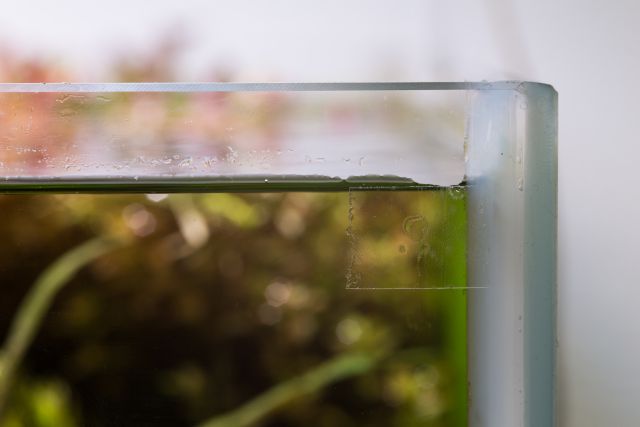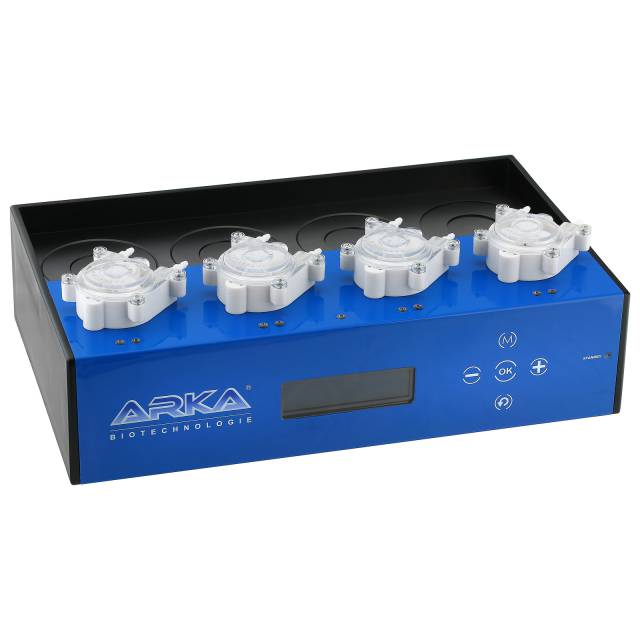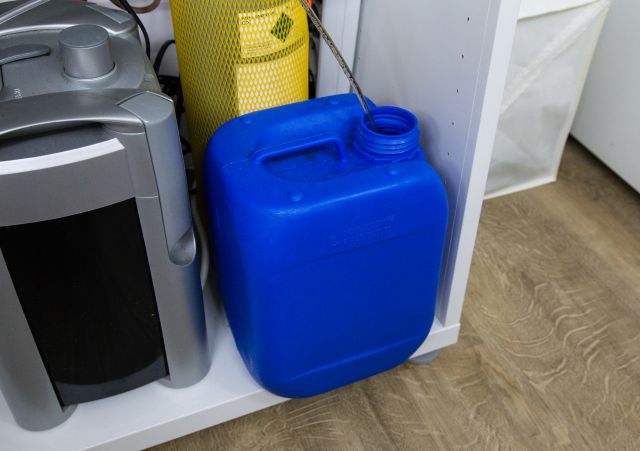Especially in open aquariums without a lid, little by little a smaller or bigger amount of water will evaporate, depending on the conditions provided by the surroundings. A sizable temperature gradient between the air and the water temperature, very dry air, a strongly moving water surface or the use of a skimmer speed up water evaporation. As a result, the water level drops steadily. But not only this, the parameters of the aquarium water will change as well. Since only pure water (H 2O) evaporates, all dissolved substances stay in the remaining water and thus inside the aquarium. These solutes include, among others, minerals that affect the nutrient situation and the water hardness in the aquarium. In a marine tank, evaporation will increase the salinity and thus the density of the water, and in a freshwater aquarium, the water hardness and possibly also the nutrient content will rise.
To compensate for water lost through evaporation and to restore the initial conditions, only pure, demineralized water should be used. It is best to rely on water that has been purified in a reverse osmosis system or in a demineralizer for the top-up. There are different ways to add this water to the aquarium.
Manual addition
If the water level has dropped noticeably, you simply refill the aquarium on sight with demineralized water. For orientation, use a marking on the aquarium glass you have previously applied. During a manual refill, most aquarium keepers just pour the purified water into their tanks from a bucket or a watering can until the desired level is reached. Unfortunately, this method may lead to very sudden changes of the water parameters, especially when larger quantities of water are filled in, which can stress the more sensitive amongst the animals in our aquaria. It’ll also mess up your scape if you’re not careful. (For further information, please see our article on water changes). We recommend storing the purified water for a couple of days at room temperature so there are at least no sharp temperature drops.

An inconspicuous, transparent adhesive strip serves as a water level marker.
Semi-automated with a dosing pump
It's much easier - and much gentler for the residents - if the refilling process is done automatically. A dosing pump is a neat tool for that. Multi-channel pumps are in popular use for automated fertilization. If you still have a free channel, you can use it to simplify the top-up with RO water. If you want to follow this method, however, you'll first need to calculate how much water evaporates on average within a certain period of time.

Calculations
To determine this parameter, first fill the aquarium to the ideal level and mark the waterline on one of the glass panes. After a week - during which you don’t top up - the level will have dropped significantly. Now you measure the distance between the original and the current water level with a tape measure. Then multiply this value with the length and width of your aquarium (also in centimeters). The result of this calculation gives you the amount of water in milliliters that has evaporated in the course of one week. To determine the average daily consumption, you need to divide that number by seven.
As an example: In a standard aquarium with a volume of 54 liters (60 cm in length, 30 cm in width, 30 cm in height), the water level drops by 2 cm within one week. Now we multiply that with the length and width of the aquarium: 2 x 60 x 30 = 3600. So 3600 ml - or 3.6 liters of water - evaporate every week. Next, the daily consumption is determined: 3600 divided by 7 = about 514. This gives us a daily evaporation of 514 milliliters - about half a liter of water.
Once you have determined the daily consumption, you can set the control unit of your dosing pump to automatically add that amount of water daily. It is particularly gentle for the aquarium animals if you divide the addition into several smaller portions. For many dosing pumps, the addition interval for one channel can be increased. As a result, the refill water is not introduced once a day in a larger amount, but in fractions and more often. This results in far less irritation and stress for the aquarium’s inhabitants that would be created by harshly changing water parameters.

The container that holds the refilling water to feed the dosing pump should be sufficiently large. The more volume, the less often you’ll have to fill it up. It makes sense to choose a volume that is at least equal to the weekly water consumption due to evaporation, i. e. you will only have to refill with demineralized water once a week.
Safety instructions: Since the evaporation rate in the aquarium may fluctuate due to various factors (such as the season), the amount added should be regularly monitored, and if necessary, adjusted, especially during the first months. Possible measurement errors also need to be corrected. If the amount of water that is added is too large, the aquarium might overflow. Therefore you should mark the ideal filling level of the aquarium on one side of the aquarium, and check it frequently. The water should never rise (significantly) above this mark! It is also advisable to plan for a certain void volume from the ideal level to the absolute upper edge of the glass tank that serves as a buffer area if the ideal level is exceeded by accident.
Fully automatic
Another possibility is the purchase of a fully automatic refill system. These water level regulators are equipped with a dosing pump, which is connected to a reservoir. In addition, one or more sensors (optical or floating) are connected to this system.They will detect a drop in the water level in the aquarium and automatically top up the tank and bring the water level back to standard.